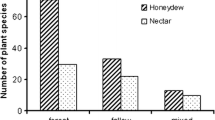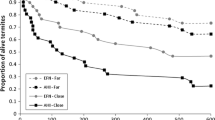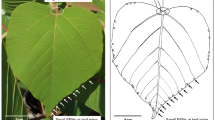Summary
Qualea grandiflora is a typical tree of Brazilian cerrados (savanna-like vegetation) that bears paired extrafloral nectaries (EFNs) along its stems. Results show that possession of EFNs increases ant density on Q. grandiflora shrubs over that of neighbouring non-nectariferous plants. Frequency of ant occupancy and mean number of ants per plant were much higher on Qualea than on plants lacking EFNs. These differences resulted in many more live termitebaits being attacked by foraging ants on Qualea than on neighbours without EFNs. Termites were attacked in equal numbers and with equal speeds on different-aged leaves of Qualea. The greatest potential for herbivore deterrence was presented by Camponotus ants (C. crassus, C. rufipes and C. aff. blandus), which together attacked significantly more termites than nine other ant species grouped. EFNs are regarded as important promoters of ant activity on cerado plants.
Similar content being viewed by others
References
Barton AM (1986) Spatial variation in the effect of ants on an extrafloral nectary plant. Ecology 67:495–504
Bentley BL (1977) Extrafloral nectaries and protection by pugnacious bodyguards. Ann Rev Ecol Syst 8:407–427
Boucher DH, James S, Keeler KH (1982) The ecology of mutualism. Ann Rev Ecol Syst 13:315–347
Delpino F (1875) Rapporti tra insetti e tra nettari estranuziali in alcune piante. Boll della Soc Entomol (Florença) 7:69–90
Elias TS (1983) Extrafloral nectaries: their structure and distribution. In: BL Bentley, TS Elias (eds), The Biology of nectaries. Columbia University Press, New York, pp 174–203
Gibbs PE, Leitão-Filho HF, Shepherd GJ (1983) Floristic composition and community structure in an area of cerrado in SE Brazil. Flora 173:433–449
Goodland R (1971) A physiognomic analysis of the cerrado vegetation of central Brazil. J Ecol 59:411–419
Janzen DH (1967) Interaction of the bull's horn acacia (Acacia cornigera L.) with an ant inhabitat (Pseudomyrmex ferruginea F. Smith) in eastern Mexico. Univ Kans Sci Bull 47:315–558
Jeanne RL (1979) A latitudinal gradient in rates of ant predation. Ecology 60:1211–1224
Kempf WW (1972) Catálogo abreviado das formigas da região Neotropical. Studia Entomol 15:3–334
Koptur S (1984) Experimental evidence for defense of Inga (Mimosoideae) saplings by ants. Ecology 65:1787–1793
McKey D (1984) Interaction of the ant-plant Leonardoxa africana (Caesalpinaceae) with its obligate inhabitants in a rainforest in Cameroon. Biotropica 16:81–99
Messina FJ (1981) Plant protection as a consequence of an antmembracid mutualism: interactions on goldenrod (Solidago sp.). Ecology 62:1433–1440
Morais HC (1980) Estrutura de uma comunidade de formigas arborícolas em vegetação de campo cerrado. Master's thesis, Universidade Estadual de Campinas, Campinas, São Paulo
Oliveira PS, Leitão-Filho HF (1987) Extrafloral nectaries: their taxonomic distribution and abundance in the woody flora of cerrado vegetation in southeast Brazil. Biotropica 19:140–148
Schemske DW (1980) The evolutionary significance of extrafloral nectar production by Costus woodsonii (Zingiberaceae): an experimental analysis of ant protection. J Ecol 68:959–967
Author information
Authors and Affiliations
Rights and permissions
About this article
Cite this article
Oliveira, P.S., da Silva, A.F. & Martins, A.B. Ant foraging on extrafloral nectaries of Qualea grandiflora (Vochysiaceae) in cerrado vegetation: ants as potential antiherbivore agents. Oecologia 74, 228–230 (1987). https://doi.org/10.1007/BF00379363
Received:
Issue Date:
DOI: https://doi.org/10.1007/BF00379363




